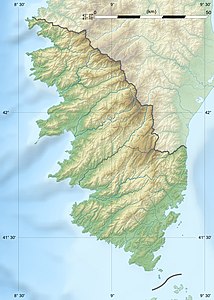Îles Lavezzi
| Îles Lavezzi | ||
|---|---|---|
| Île Lavezzi | ||
| Waters |
Strait of Bonifacio , Tyrrhenian Sea |
|
| Geographical location | 41 ° 20 ′ N , 9 ° 15 ′ E | |
|
|
||
| Main island | Ile de Cavallo | |
| Residents | uninhabited | |
The Lavezzi are a little out of about 100 islands and reefs, usually made of granite, existing group of islands in the Strait of Bonifacio between Corsica and Sardinia . It is located about four kilometers from the Corsican mainland.
The group includes the islands of Île de Cavallo , Piana, Ratino , Poraggia and Perduto . With the exception of the island of Cavallo, the archipelago belongs to the municipality of Bonifacio . Since 1982 the archipelago and its waters have been declared a French nature reserve Réserve Naturelle des Bouches de Bonifacio . Only the islands of Lavezzi, Cavallo and Piana are allowed to be entered by holidaymakers.
The tangle of reefs and small and large islands, some of which are hidden under the surface of the water, is a difficult area for shipping. In spring, autumn and winter, strong winds and storms often create strong currents between the islands and reefs. Since 1874, a lighthouse built on the rock of Pointe Becchi has made it easier for ships to navigate.
In the vicinity of the Lavezzi Islands there is a rare fauna and flora. For example, rare coral gulls and underwater starfish , gorgonians (horn corals), scorpion fish , groupers and schools of tuna can be observed. The species-rich island vegetation also includes fragrant wild herbs such as laurel , myrtle and gorse , but also thyme and coppertop lavender .
The southernmost point of France in Europe is located on the Lavezzi Islands .
The shipwreck of the Sémillante
In 1855 the biggest shipwreck of a French ship in the Mediterranean took place here, the shipwreck of the frigate Sémillante :
The three-master was one of the last wooden sailing ships . He ran under Napoléon III. on February 14, 1855 with a total of 702 men, including the general staff, 301 sailors of the crew and 392 soldiers as supplies for the Crimean War on board from Toulon . Due to lack of time, it was decided not to sail the long stroke around sardines, but through the Strait of Bonifacio . Due to a storm and heavy fog and probably the loss of the steering wheel, the ship crashed on February 15 on the reefs of the Lavezzi Islands. On February 16, the first items such as swords and clothing were washed ashore near Bonifacio; on the 18th the first drowned man was seen a nautical mile from the scene of the accident. By March 20, a total of 592 bodies had been recovered from the coasts of Corsica and Sardinia. Two cemeteries were laid out for burial, one on Lavezzi and the other in northern Sardinia. Both cemeteries are still maintained. Only the commander Jugnan could be identified by his insignia and a deformation of a foot. The other victims remained missing. A memorial was erected on the main island of Lavezzi in honor of the castaways.
The French writer Alphonse Daudet (1840–1897) made the shipwreck of the Sémillante world famous through one of the “Letters” published in 1866 under the title Lettres de mon moulin .
In 2000 the city of Bonifacio had a plaque of honor unveiled to commemorate the event. Even today, the Corsicans honor the victims every year with a memorial ceremony.
literature
- Roger Beveraggi: Un naufrage célèbre, La Sémillante . Imprimerie Trèfle, Paris 2004, ISBN 2-84871-626-6 .
Individual evidence
- ↑ Réserve Naturelle des Bouches de Bonifacio (French)
- ↑ Indication of the prefecture

